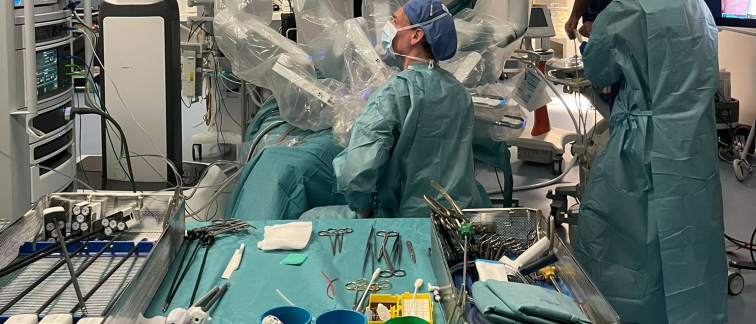Recently, a pioneering procedure took place at Amsterdam UMC's hybrid operating room: during the same operation, both a robot-assisted liver resection and a CT-guided liver ablation were performed concurrently. Surgeon Rutger-Jan Swijnenburg and Interventional Radiologist Professor Martijn Meijerink led this pioneering combined procedure after months of preparation.
Two innovative methods
For treating liver tumors, such as metastases of colorectal cancer, there are two widely used methods: liver resection and liver ablation. In a liver resection, the surgeon removes a part of the liver where the tumor is located, oftentimes using a robot for assistance. Liver ablation involves destroying the tumor locally with heat. A CT scan is optimal to guide the treatment. The goal of both procedures is to completely remove or destroy tumor tissue while preserving as much healthy liver tissue as possible.
Combining two treatments into one
Often, surgeons combine these two treatments in one patient, such as when there are multiple liver tumors or when the location within the liver is challenging. Rutger-Jan Swijnenburg explains: "Until now, these procedures could only be done separately or with less precise techniques through a large incision in the abdomen or traditional laparoscopic surgery without a CT scanner. The patient had to undergo two separate hospital stays and receive anesthesia twice. By performing both procedures within one operation, we minimize the burden on the patient."
Advanced equipment
Martijn Meijerink comments: "Our ablation techniques have made tremendous progress over the past few years. We work with the most advanced equipment to improve our treatments and reduce the impact on patients."
Research into effectiveness
Before this combined treatment becomes available for all patients with liver tumors, further research is being conducted to assess its effectiveness and safety. Currently, 15 patients are involved in this study. If the procedure proves safe and effective compared to the two separate operations, a larger-scale effectiveness study will be conducted involving other UMCs. Rutger-Jan Swijnenburg hopes that this new treatment will become accessible to all patients with liver tumors within three years.

